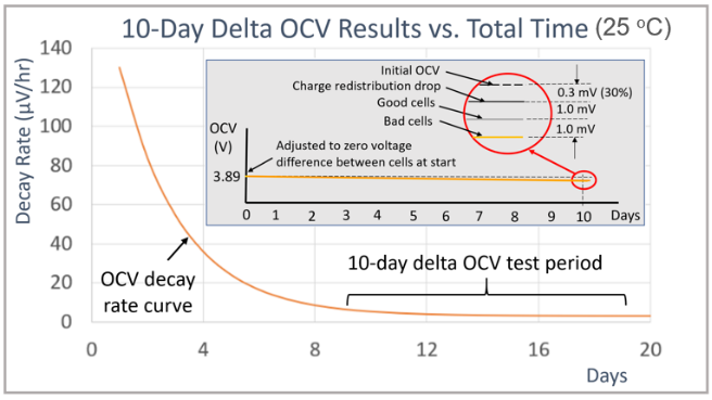eMark
100 kW
It's really your responsibilty (not the manufacturer) to Pre-TEST your Brand New 18650 cells and decide whether you'd rate them as Grade A or Grade B before building your pack. Hopefully, saving you some future frustration. You'll need to devise your own benchmarks for grading new cells, cells from a used pack or bargain basement salvaged cells. Then sort the cells according to the best use: Raw Performance, Casual Crusing or another application.
It's your call how precise to be (e.g. 0.001V, 0.005v, 0.010v -- A, B, C) depending on the application. Depending on your criteria you may disqualify more cells that you were led to believe were Grade A cells, because 10% of the cells fail according to your pre-test benchmark as not being Grade A According to your demarcation line between A & B.
The following diagrams are from an article on how the Delta OCV (self-discharge) of NEW cells is measured. The unknown is the percent of a manufacturing run that's tested with the objective being zero defect tolerance. Thus how manufactures arrive at what they consider Grade A cells and Grade B cells. Every manufacturer determines what they consider the allowable difference between a Grade A cell and a Grade B cell. Manufactures use the more expensive Potentiostatic Method for grading cells because of its immediacy (within 1-2 hrs) ...

Two methods for determining Delta OCV self-discharge whether new cells, useful pack cells or unknown salvaged bargain basement 18650 cells

This is basically the method that goatman and i are using to test capacity and self-discharge of his 30Q 17s4p and my 30Q 10s3p. Because our cells are not new (many c/d cycles) we decided to rest our packs (equalize cell voltage) for 5 days instead of 10 days because only -0.001mV after 5 days is unlikely with our used (problematic 30Q) cells. Moreso the scenario with my pack then goatman's **regenerated** pack.
We started our tests on December 16th and have been PMing each other to establish testing criteria, resulting data of our two used 30Q packs and what comparative results to share (KIS). Hopefully easy enuf for others to follow along and participate with their own suggestions, testing criteria, test data, etc. We'll start sharing our comparative results in a couple days.
Both 30Q packs (Plasti-Dipped 17s4p & Vruzend V2.1 10s3p) were equalized with p-groups (68 cells & 30 cells) at 3.228v avg & 3.226v (17s4p & 10s3p) before charging to 90% at 2.0A rate instead of FULL at 4.20v. Charge time could've been shortened by only charging p-groups to 3.90v (70% charge) as shown in above chart, but we both wanted to see what p-group capacity was with a 90% charge. Temperature 75°F during 17s4p charge at 2.0A rate. Temperature 73°F during 10s3p 2.0A charge.
While we decide how best to go about sharing our comparative Delta OCV info (storage capacity & self-discharge) the following article gives an idea how manufaturers go about testing 18650 cells ... https://www.batterytechonline.com/testing-and-safety/measuring-lithium-ion-cell-self-discharge
It's your call how precise to be (e.g. 0.001V, 0.005v, 0.010v -- A, B, C) depending on the application. Depending on your criteria you may disqualify more cells that you were led to believe were Grade A cells, because 10% of the cells fail according to your pre-test benchmark as not being Grade A According to your demarcation line between A & B.
The following diagrams are from an article on how the Delta OCV (self-discharge) of NEW cells is measured. The unknown is the percent of a manufacturing run that's tested with the objective being zero defect tolerance. Thus how manufactures arrive at what they consider Grade A cells and Grade B cells. Every manufacturer determines what they consider the allowable difference between a Grade A cell and a Grade B cell. Manufactures use the more expensive Potentiostatic Method for grading cells because of its immediacy (within 1-2 hrs) ...

Two methods for determining Delta OCV self-discharge whether new cells, useful pack cells or unknown salvaged bargain basement 18650 cells

This is basically the method that goatman and i are using to test capacity and self-discharge of his 30Q 17s4p and my 30Q 10s3p. Because our cells are not new (many c/d cycles) we decided to rest our packs (equalize cell voltage) for 5 days instead of 10 days because only -0.001mV after 5 days is unlikely with our used (problematic 30Q) cells. Moreso the scenario with my pack then goatman's **regenerated** pack.
We started our tests on December 16th and have been PMing each other to establish testing criteria, resulting data of our two used 30Q packs and what comparative results to share (KIS). Hopefully easy enuf for others to follow along and participate with their own suggestions, testing criteria, test data, etc. We'll start sharing our comparative results in a couple days.
Both 30Q packs (Plasti-Dipped 17s4p & Vruzend V2.1 10s3p) were equalized with p-groups (68 cells & 30 cells) at 3.228v avg & 3.226v (17s4p & 10s3p) before charging to 90% at 2.0A rate instead of FULL at 4.20v. Charge time could've been shortened by only charging p-groups to 3.90v (70% charge) as shown in above chart, but we both wanted to see what p-group capacity was with a 90% charge. Temperature 75°F during 17s4p charge at 2.0A rate. Temperature 73°F during 10s3p 2.0A charge.
While we decide how best to go about sharing our comparative Delta OCV info (storage capacity & self-discharge) the following article gives an idea how manufaturers go about testing 18650 cells ... https://www.batterytechonline.com/testing-and-safety/measuring-lithium-ion-cell-self-discharge


